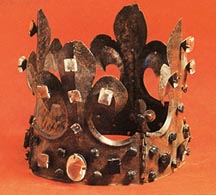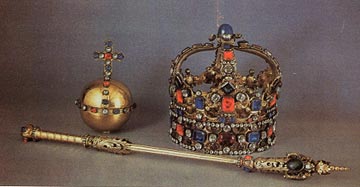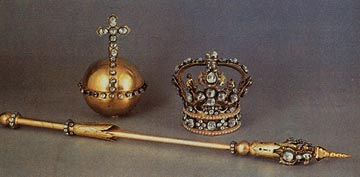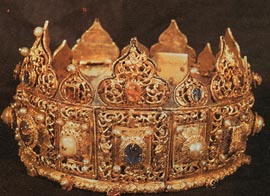

The Significance of the Crown
the Sandomierz area. This crown may have belonged to Casimir the Great(?). |
 |
POLAND'S CROWNS:
During the first three hundred years, of the Polish State, crowns and other royal regalia was kept at Wawel Castle only from time to time. It was not until after the cornation of Ladislaw Lokietek ("the elbow high"), that they remained there to form the crown treasury.
The last inspection of the Royal Treasury of Poland took place in 1792. The Seym appointed two commisioners: Tadeusz Czacki and Jan Horain, to carry out this task. The Polish Regalia had remained housed in the Royal Castle (Wavel) since the coronation of Stanislaus Augustus in Warsaw, Poland. By 1792, the Treasury was not as rich as in the days of the Jagiellon Dynasty. A three-day exhibit was held in the castle and townsfolk bought tickets to view this display, on April 18, 1792.
This regalia remained intact until 1795. At this time, there were five gold crowns of Poland:
A fifth crown (The Russian Crown) was given to Poland by Wladislas IV which was deposited with the Kurfurst of Brandenburg in the Prussian Treasury.
After these items were intentoried, they were wrapped in cotton fabric and placed in sealed and locked chests, then the doorway to the treasury was locked. The doors were not opened again until 1794, when the town was invaded by the Prussians. The Prussians occupied Wawel Castle for a year and one-half.

There were also four scepters, five orbs and two swords (the Szczerbiec and the Sigismund Sword).
King Frederick William II of Prussia ordered the regalia to be stolen and secretly removed, in 1795,to Wroclaw, and later Berlin. These items were then destroyed in Konigsburg in 1809. The gold went to the mint and the precious stones and pearls were sold for profit. Some lesser items went to the Prussian royal collection and other things were sold all over the world. It is said that a retired artillery captain, named Zubrzycki led the Prussians to the treasury. Quite literally everything was removed, including the inlaid floors.

Tadeusz Czacki gave a small fraction of these treasures to Isabella Czartoryska nee Fleming in Pulawy. These items were later housed in the Princess Czartoryski Museum in Cracow. They remained there until Poland's independence. The Szczerbiec sword was from Russia and was used from the 1320's onward. The Sigismund Sword was used from the 16th century.
Poland has been working to recover all its artwork ever since.
During a visit to Berlin, in 1798, Felix Lubienski, the Sheriff of Naklo, was in audience at the court of King Frederic Wilhelm III. At this event, he saw the necklace worn by Queen Luisa contained the same jewels that were originally set in the Polish Crowns. Rumors circulated that the Crown Jewels were saved. The evidence, before his eyes, showed that they were stolen. IN 1817, the State Sword was discovered in the Hermitage Museum.
OTHER MISSING ITEMS:
In the year 100, the German Emperor Otto presented this lance to King Boleslaw. It was copied after the Holy Lance of St. Maurice. This was another treasure of the Poles. The Cornation Sword, which had no real material value, was to reappear in 1817, from Berlin, Germany. Records from 1700 listed most of the Polish regalia catalogued in Berlin books.
The Sandomierz crown was found buried under a tree in 1912. This crown is a copy of the original, which was made in the 14th century. It closely resembles the Crown of St. Casimir the Great, which was buried in his tomb. Both crowns had four fleur-de-Lis, and are often labelled as the same crown.
LORE OF THE CROWN:
The first crowns were the marks of Chieftanship, and they were emblems of sovereignty.
In the 13th century, fashion favored the wearing of many jewels. Fine jewelry constituted a sort of badge of rank. In 1283, the Ordonnances forbid bourgeois and their ladies from the wearing of precious stones, belts of gold or coronals of gold or silver. Men and women of noble birth wore their finest jewels only on state occasions upon their head. "Some of the grandest coronets seem to have been worn by women. Eleanor of Provence owned a great number of garlands and chaplets for the hair, of the richest kind: she had nine when she married Henry III in 1236 and bought eleven (11) more later" (Evans, Joan, A History of Jewellery 1100-1870. New York: Dover Publications, Inc., 1970). The Countess of Artois had four crowns of jewelled gold. An eight-sided crown, now at Namur set with the relics of the original "Crown of Thorns" was sent from Constantinople by Emperor Henry to his brother Philip, the Marquis of Namur in 1205. Another crown was given by St. Louis to the Dominicans of Liege. This crown was fashioned with eight silver gilded plaques with fleur-de-lis linked by many winged angels. The plaque was decorated with oak leaves (symbolizing strength) and was set with cabochon jewels and classical intaglios. Blanche of Castile (1188-1252), Queen regent of France, had a gold crown set with rubies, emeralds, and large pearls. Another was set with oriental pearls, and yet another with rubies and emeralds. The coronation crown featured large balas rubies (red spinel), surrounded by emeralds, pearls, oriental sapphires, and rubies.
 | the second quarter of the 13th century. This crown was hermetically sealed with the contents of the reliquary of St. Zigmund (c. 1370). |
The taste of men was simpler. "Edward I (1299-1300) wore two golden ouches set with cameos, a fermail with a ruby and small garnet that he wore, another with rubies and emeralds that his Queen had given him" (Evans). A number of jewels, worned by Caterina Jagellonica, Queen of Sweden, were buried in her tomb in Upsala Cathedral. War Prince Czartoryski owned a pendant crowned with two putti resting along the gable of the his initials. Jewels with initials were popular at this time, and many of their jewels were designed by Hans Mielich, a Munich man who distinguished himself as a designer of jewels.
Kings wore crowns in battle, much like men wore arms, to be recognized. The medieval feudal system worked as people united together for the common cause. Jewels were often given in favor to members of the court and other people who gave good service to the crown.
Esteicher, Karol. The Mystery of the Polish Crown Jewels. Chicago, IL.: Heraldry Unlimited (reprint)
Szablowski, Jerzy (editor). Collections of the Royal Castle of Wawel. Warsaw: Publishing House Arkady, 1994, 25.

center>

